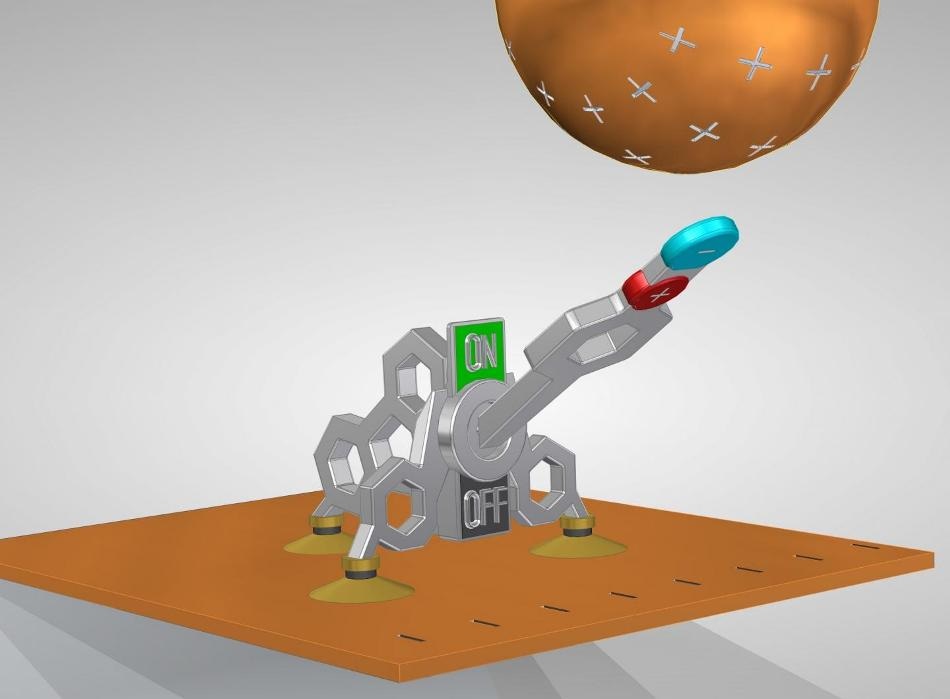Mar 13 2017
 Schematic of a tripodal single molecule switch. The height of the molecular head, containing a dipolar group, can be changed through applied electric fields. In this way an electric current can flow between the gold electrodes through the molecule or not, the switch is "on" or "off." (Credit - Prof. Fabian Pauly, University of Konstanz)
Schematic of a tripodal single molecule switch. The height of the molecular head, containing a dipolar group, can be changed through applied electric fields. In this way an electric current can flow between the gold electrodes through the molecule or not, the switch is "on" or "off." (Credit - Prof. Fabian Pauly, University of Konstanz)
Theoretical physicists, Junior Professor Fabian Pauly and his postdoc Dr. Safa G. Bahoosh, recently succeeded with a team of experimental physicists and chemists in exhibiting a reliable and reproducible single molecule switch. The core for this switch is an exclusively synthesized molecule possessing special attributes.
This is a significant step towards achieving primary ideas of molecular electronics. The research findings were published on 9 March 2017 in the online journal Nature Communications.
Fabian Pauly compares the molecule, which was synthesized by Professor Marcel Mayor who is affiliated to the University of Basel in Switzerland and to the Karlsruhe Institute of Technology (KIT) in Germany, with a three-legged lunar landing spacecraft that consists some type of head on top and is erect on the moon's surface.
Its three "legs" possess anchor groups that form strong links to the surface - in this case a gold substrate. A nitrile group, placed at its "head", points away from the gold surface and is therefore well separated from it. A second electrode, the gold tip of a scanning tunneling microscope, can connect and set up contact. In this manner, electric current can flow via the molecule.
With the highly precise method of the scanning tunneling microscope, it has become possible for such an intricate three-legged molecule to measure the conductance value at every position above the nitrile group for the first time. Length control falling in the range of picometers, the trillionth part of a meter, is needed for this process.
The nitrile group's dipole moment, i.e. an electric plus-minus charge, facilitates both mechanical control as well as control through electric fields. The voltage between the electrodes can be used to regulate the height of the head, as was shown by Safa G. Bahoosh in theoretical calculations.
The molecule's head is pressed down when a positive field is applied. If the field turns out to be negative due to polarity reversal, the head moves up. This means that the contact can be electrically set up or broken, and the current can be switched on and off.
What's really great about this result is that we have a well-defined on and off state.
Fabian Pauly, Junior Professor, University of Konstanz
Earlier concepts frequently failed because it was too hard to control the electronic contact to single molecules and only statistical interpretations of the actions of molecular contacts could be done.
Presently, for the first time, contact between the gold tip of the scanning tunneling microscope and a molecule could be opened and closed reproducibly several thousand times both electrically and mechanically, without resulting in any plastic deformations.
Fabian Pauly's team member Safa G. Bahoosh, who has recently acquired funding from the German Research Foundation (DFG) for her position spanning the next three years, used density functional theory to measure geometric structures, electric conductance values, and the images that would be created by the scanning tunneling microscope.
With her simulations she could predict the individual molecule’s shape on the surface. Her results match with the experiments performed at the KIT. There, headed by Dr. Lukas Gerhard and Professor Wulf Wulfhekel, the electron transport was measured using the scanning tunneling microscope.
In addition to the switching functionality, the theoretical simulations integrated with the systematic experiments show new insights into minuscule energies and forces that take place during reconfigurations in molecular contacts.